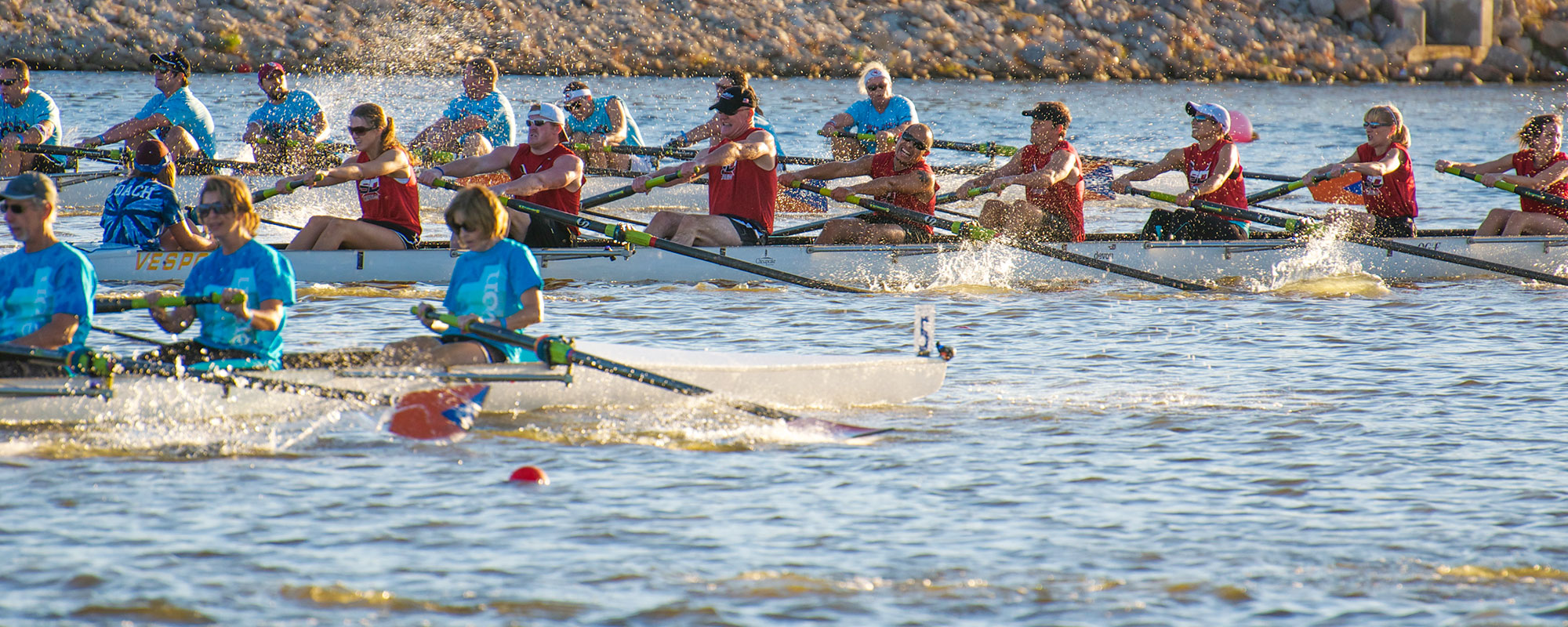
Tips for Watching
Rowers typically race one of two types of races, a head race or a sprint.
Sprint Races
Sprint races are held in the spring and are 2,000 meters, or approximately 1.25 miles. The racecourse is divided into six lanes and each 500-meter section is marked with buoys. At the Oklahoma River, sprint races start east of I-35 and proceed west toward the Chesapeake Finish Line Tower.
The race begins with all boats aligned at the start in the lanes they’ve been assigned. Each crew is allowed one false start; two means disqualification. If within the first 100 meters there is legitimate equipment breakage (e.g., an oar snaps in two), the race will be stopped and restarted with repaired equipment.
The stroke rate (the number of rowing strokes per minute that a crew is taking) is high at the start, then, the crew will “settle” into the body of the race and drop the rating back. Higher stroke rates are not always indicative of speed. A strong, technically talented crew may be able to cover more water faster than a less-capable crew rowing a high stroke rate.
Head Races
Head races are held in the fall and are typically 5,000 meters or approximately 3 miles. The race begins with boats released at 10 to 15 second intervals. Rowers race against the clock with the winning time being announced after all boats in the division have crossed the finish line. At the Oklahoma River, head races start at the Western dam and proceed east with the finish line east of I-35.
Whether it’s a head race or a sprint, rowing events are divided into two disciplines – sweep rowing and sculling – and two categories within those: lightweight and open. Races are further divided by age bracket, usually defined as juniors and masters, with handicapping for the various age groups within the masters.
You may see dozens of races during a regatta, each showcasing the athletic skill of rowers within a specific category. The crew that’s making it look easy is most likely the one doing the best job. While you’re watching, look for –
- Continuous, fluid motion of the rowers. The rowing motion shouldn’t have a discernible end or beginning.
- Synchronization. Rowers strive for perfect synchronization in the boat.
- Clean catches of the oar blade . If you see a lot of splash, the oar blades aren’t entering the water correctly. The catch should happen at the end of the recovery, when the hands are as far ahead of the rower as possible. Rowers who uncoil before they drop the oar blades are sacrificing speed and not getting a complete drive.
- Even oar blade feathering. When the blades are brought out of the water, they should all move horizontally close to the water and at the same height. It’s not easy, especially if the water is rough.
- The most consistent speed. Shells don’t move like a car – they’re slowest at the catch, quickest at the release. The good crews time the catch at just the right moment to maintain the speed of the shell.
- Rowing looks graceful, elegant and sometimes effortless when it’s done well. Don’t be fooled. Rowers haven’t been called the world’s most physically-fit athletes for nothing. A 2,000-meter rowing race demands virtually everything a human being can physically bring to an athletic competition – aerobic ability, technical talent, exceptional mental discipline, ability to utilize oxygen efficiently and in huge amounts, balance, pain tolerance, and the ability to continue to work when the body is demanding that you stop.
- If a crew “catches a crab,” it means the oar blade has entered the water at an angle instead of perpendicularly. The oar blade gets caught under the surface and will slow or even stop a shell.
- A “Power 10″ is a call by the coxswain for 10 of the crew’s best, most powerful strokes. Good coxswains read the course to know how many strokes remain for their crew to count down to the finish.
- Identifying a crew. Crews are identified by their oar blade design. OCU blades are blue with a white star. OU blades are crimson and cream, and the OKC RIVERSPORT design is blue and orange.
- Into the water! Coxswains from first-place boats worldwide are thrown into the water by their crews. Coxswains don’t now and probably never did yell “stroke! stroke!” Similar to a jockey, their job is to implement the coach’s strategy during the race, in addition to steering and letting the rowers know where they stand in the race and what they need to do to win.
Adapted from www.usrowing.com.


